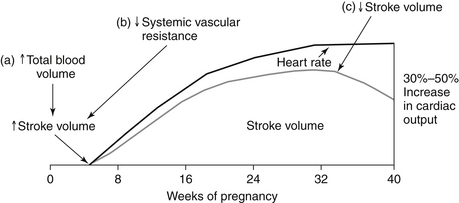Chapter 51
Heart Disease in Pregnancy
1. What cardiac physiologic changes occur during pregnancy?
Hormonal changes cause an increase in both plasma volume (from water and sodium retention) and red blood cell volume (from erythrocytosis) during a normal pregnancy. A disproportionate increase in plasma volume explains the physiologic anemia of pregnancy. Maternal heart rate (HR) increases throughout the 40 weeks, mediated partially by increased sympathetic tone and heat production. Stroke volume subsequently continues to increase until the third trimester, when inferior vena cava (IVC) return may be compromised by the gravid uterus. Maternal cardiac output increases by 30% to 50% during a normal pregnancy. Systolic blood pressure drops during the first half of pregnancy and returns to normal levels by delivery. The physiologic changes related to cardiac output that occur during pregnancy are shown in Figure 51-1.
2. Are there independent vascular changes that occur during a normal pregnancy?
3. What are normal cardiac signs and symptoms of pregnancy?
 Hyperventilation (as a result of increased minute ventilation)
Hyperventilation (as a result of increased minute ventilation)
 Peripheral edema (from volume retention and vena caval compression by the gravid uterus)
Peripheral edema (from volume retention and vena caval compression by the gravid uterus)
 Dizziness/lightheadedness (from reduced SVR and vena caval compression)
Dizziness/lightheadedness (from reduced SVR and vena caval compression)
4. What are pathologic cardiac signs and symptoms of pregnancy?
 Anasarca (generalized edema) and paroxysmal nocturnal dyspnea are not components of normal pregnancy and warrant workup.
Anasarca (generalized edema) and paroxysmal nocturnal dyspnea are not components of normal pregnancy and warrant workup.
 Syncope warrants evaluation for pulmonary embolism, tachy- or bradyarrhythmias, pulmonary hypertension, obstructive valvular pathology (aortic, mitral, or pulmonic stenosis), or hypotension.
Syncope warrants evaluation for pulmonary embolism, tachy- or bradyarrhythmias, pulmonary hypertension, obstructive valvular pathology (aortic, mitral, or pulmonic stenosis), or hypotension.
 Chest pain may be due to aortic dissection, pulmonary embolism, angina, or even myocardial infarction. As more women delay childbearing, there is a higher incidence of preexisting cardiac disease and risk factors in pregnant women.
Chest pain may be due to aortic dissection, pulmonary embolism, angina, or even myocardial infarction. As more women delay childbearing, there is a higher incidence of preexisting cardiac disease and risk factors in pregnant women.
 Hemoptysis may be a harbinger of occult mitral stenosis, although rheumatic heart disease is becoming less common in developed countries.
Hemoptysis may be a harbinger of occult mitral stenosis, although rheumatic heart disease is becoming less common in developed countries.
5. What are normal cardiac examination findings during pregnancy?
 Blood pressure (BP) will decline and HR will increase.
Blood pressure (BP) will decline and HR will increase.
 The point of maximum impulse will be displaced laterally as the uterus enlarges.
The point of maximum impulse will be displaced laterally as the uterus enlarges.
 S3 heart sound is common because of increased rapid filling of the left ventricle (LV) in early diastole.
S3 heart sound is common because of increased rapid filling of the left ventricle (LV) in early diastole.
 A physiologic pulmonic flow murmur is common because of elevated stroke volume passing through a normal valve.
A physiologic pulmonic flow murmur is common because of elevated stroke volume passing through a normal valve.
 A mammary soufflé (due to increased blood flow into the breasts) and venous hum (due to increased blood flow through jugular veins) are two continuous, superficial murmurs that can be obliterated by compressing the site with the diaphragm of the stethoscope. If the murmur does not change, consider patent ductus arteriosus or coronary arteriovenous (AV) fistula.
A mammary soufflé (due to increased blood flow into the breasts) and venous hum (due to increased blood flow through jugular veins) are two continuous, superficial murmurs that can be obliterated by compressing the site with the diaphragm of the stethoscope. If the murmur does not change, consider patent ductus arteriosus or coronary arteriovenous (AV) fistula.
6. What are pathologic cardiac exam findings during pregnancy?
 Clubbing and cyanosis are not a part of normal pregnancy; desaturation for any reason is abnormal and warrants investigation.
Clubbing and cyanosis are not a part of normal pregnancy; desaturation for any reason is abnormal and warrants investigation.
 Elevated jugular venous pressure (JVP) is abnormal, reflecting elevated right atrial pressure. Although edema is common in this population, it is important to evaluate neck veins in any pregnant woman with peripheral edema.
Elevated jugular venous pressure (JVP) is abnormal, reflecting elevated right atrial pressure. Although edema is common in this population, it is important to evaluate neck veins in any pregnant woman with peripheral edema.
 Pulmonary hypertension (right ventricular heave, loud P2, JVP elevation) findings should be investigated early. Women with preexisting pulmonary hypertension (pulmonary pressure greater than 75% of systemic pressure) should be counseled prior to pregnancy as to the risks.
Pulmonary hypertension (right ventricular heave, loud P2, JVP elevation) findings should be investigated early. Women with preexisting pulmonary hypertension (pulmonary pressure greater than 75% of systemic pressure) should be counseled prior to pregnancy as to the risks.
 Systolic murmur 3/6 or louder and any diastolic murmur audible in pregnancy are considered abnormal and warrant evaluation.
Systolic murmur 3/6 or louder and any diastolic murmur audible in pregnancy are considered abnormal and warrant evaluation.
 Audible S4 is unusual during pregnancy and may reflect underlying hypertension.
Audible S4 is unusual during pregnancy and may reflect underlying hypertension.
7. What are the cardiac changes that occur during labor and delivery?
Stay updated, free articles. Join our Telegram channel

Full access? Get Clinical Tree




